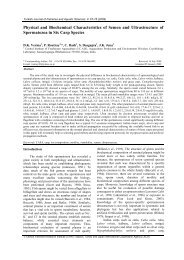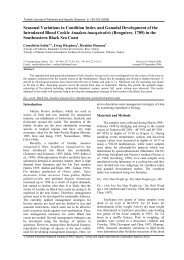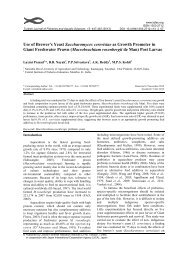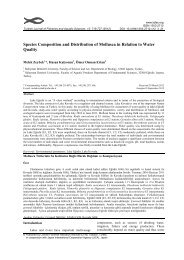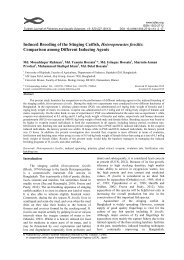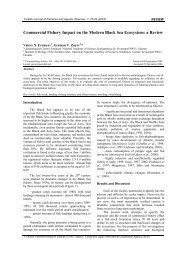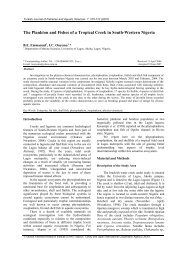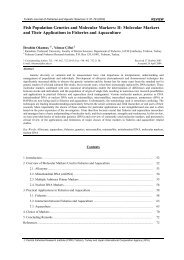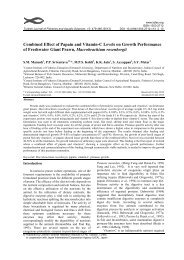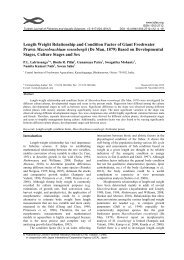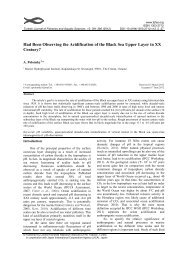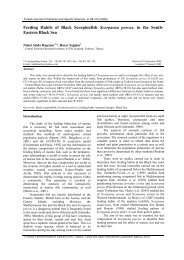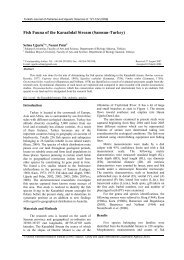Full Text - Turkish Journal of Fisheries and Aquatic Sciences
Full Text - Turkish Journal of Fisheries and Aquatic Sciences
Full Text - Turkish Journal of Fisheries and Aquatic Sciences
You also want an ePaper? Increase the reach of your titles
YUMPU automatically turns print PDFs into web optimized ePapers that Google loves.
<strong>Turkish</strong> <strong>Journal</strong> <strong>of</strong> <strong>Fisheries</strong> <strong>and</strong> <strong>Aquatic</strong> <strong>Sciences</strong> 12: 429-434 (2012)www.trjfas.orgISSN 1303-2712DOI: 10.4194/1303-2712-v12_2_33Assessment <strong>of</strong> Food Supply <strong>of</strong> Small Pelagic Fish in the Black Sea Based onTheir Lipid ContentVictor Nikolsky 1, *, Georgiy Shulman 1 , Alla Shchepkina 1 , Tatjana Yuneva 1 , Levent Bat 2 ,Yalçin Kaya 2 , Ahmet Kideyş 3 , Kadir Seyhan 41 Institute <strong>of</strong> the Biology <strong>of</strong> the Southern Seas, 2 Nakhimov av., 99011, Sevastopol, Ukraine.2 Sinop University, <strong>Fisheries</strong> Faculty, 57000 , Sinop, Turkey.3 Institute <strong>of</strong> Marine <strong>Sciences</strong>, Middle East Technical University, Erdemli, Mersin, Turkey.4 Karadeniz Technical University, Faculty <strong>of</strong> Marine <strong>Sciences</strong>, 61530, Trabzon, Turkey.* Corresponding Author: Tel.: +380.692 544110; Fax: +380.692 557813;E-mail:Received 15 March 2012Accepted 29 June 2012AbstractTotal lipids in anchovy <strong>and</strong> sprat were measured <strong>and</strong> interpreted as indicators <strong>of</strong> their nutritional condition <strong>and</strong> foodsupply for the period 2005 to 2010. High lipid content in anchovies suggested that they were able to found sufficient food <strong>and</strong>favorable environmental condition supporting their stock biomass on a certain level which was strongly limited by heavyfishing. Wide inter-annual fluctuations in anchovy l<strong>and</strong>ings could be caused by variability in yearly recruitment <strong>and</strong> due toshifts in the spatial distribution patterns <strong>of</strong> the exploited stock. Unlike anchovy, lipid reserves in sprat declined remarkably tothe lowest levels recorded during the 50-year observations period. Such a significant worsening in sprat nutritional conditionfollowed the evident warming <strong>of</strong> the Black Sea <strong>and</strong> coincided with a sharp decline in sprat catches <strong>of</strong>f Crimea. Thus, thedeterioration <strong>of</strong> food supply together with intensive fishing could have contributed to the reduction <strong>of</strong> that local sprat stock.Keywords: Anchovy, sprat, water temperature, stock biomass.IntroductionThe most abundant small pelagic forage fishes,anchovy Engraulis encrasicolus ponticus <strong>and</strong> spratSprattus sprattus phalericus, are the key fish speciesin Black Sea food web. They are important grazers <strong>of</strong>zooplankton <strong>and</strong> a main food resource for toppredators (dolphins, spiny dogfish, mackerel, whiting,turbot etc). Their early life stages are components <strong>of</strong>the diet <strong>of</strong> horse-mackerel <strong>and</strong> predatory zooplankton(Prodanov et al., 1997). Massive populations <strong>of</strong>anchovy <strong>and</strong> sprat display strong fluctuationsdepending on environmental conditions. Food supplyis one <strong>of</strong> the most important conditions determiningthe population size <strong>of</strong> small pelagics (Nikolsky,1965). In theory, the definition <strong>of</strong> ‘food supply’implies the amount <strong>and</strong> nutritional value <strong>of</strong> food, thenumber <strong>of</strong> all consumers including competitors, <strong>and</strong>specific feeding conditions. These include amongothers the temperature <strong>and</strong> transparency <strong>of</strong> water,availability <strong>and</strong> nutritional value <strong>of</strong> prey items etc(Shulman <strong>and</strong> Love, 1999).Food supply <strong>of</strong> organisms or populations can beexpressed numerically as the ratio between foodconsumed <strong>and</strong> food required but direct determinations<strong>of</strong> these two variables are very difficult whenstudying fish in nature. An indirect approach is toevaluate fish condition that ultimately depends onquantity <strong>and</strong> quality <strong>of</strong> consumed food. Many authorsproposed fat content (triacylglycerols) or total lipidcontent as a good indicator <strong>of</strong> the fish nutritionalcondition (Håkanson, 1989; Lasker, 1970; Shulman,1974; Garcia-Franco et al., 1999; Marshall et al.,1999; Shulman <strong>and</strong> Love, 1999; Orlova et al., 2010<strong>and</strong> others). However, few publications used the lipidbasedindicators with emphasis on estimation <strong>of</strong> longtermvariability in food supply <strong>of</strong> fish.The objective <strong>of</strong> this research was to determinethe nutritional condition <strong>of</strong> these fish over the pastdecade compared to earlier historical data. The longrangegoal is to develop a method for forecasting thefish stocks nutritional condition <strong>and</strong> hence, foodsupply. A long-term data series (1960 to present) <strong>of</strong>lipid accumulation in sprat populations provides a richresource for retrospective data analyses <strong>of</strong> the fishcondition which are thought to be driven byanthropogenic effects <strong>and</strong> climatic impact. Evidentiallinks between the condition <strong>of</strong> the sprat <strong>and</strong> theenvironmental characteristics <strong>of</strong> the Black Sea havebeen found (Shulman et al., 2005), <strong>and</strong> initialattempts to predict probable changes in the nutritionalcondition <strong>of</strong> sprat have been made (Nikolsky <strong>and</strong>Shulman, 2005; Nikolsky et al., 2009).© Published by Central <strong>Fisheries</strong> Research Institute (CFRI) Trabzon, Turkeyin cooperation with Japan International Cooperation Agency (JICA), Japan
430 V. Nikolsky et al. / Turk. J. Fish. Aquat. Sci. 12: 429-434 (2012)Materials <strong>and</strong> MethodsTo monitor inter-annual changes in fishnutritional condition, anchovy <strong>and</strong> sprat had beenexamined at the end <strong>of</strong> their feeding periods (June-July for sprat <strong>and</strong> October-November for anchovy)between 2005 <strong>and</strong> 2010. The techniques <strong>of</strong> sampling<strong>and</strong> determination <strong>of</strong> lipid content in small pelagicfish had been explicitly described earlier (Shulman etal., 2005). Specimens (not less than 100 fish) weresampled from each catch. Fish were sized at 5 mmintervals, <strong>and</strong> then every size group was separatelyhomogenized. About 10–15 g <strong>of</strong> homogenate wasdried at 100–105°C to a steady weight. Lipid content<strong>of</strong> fish was estimated using the relationship betweentotal lipid <strong>and</strong> dry matter contents (Nikolsky et al.,2009). An average weighted value was calculatedthen for each sample by equation:1X Nk1n i x i,where n i is number <strong>of</strong> fish in size group i, x i islipid content in size group i, k is number <strong>of</strong> sizegroups, <strong>and</strong> N is number <strong>of</strong> all fish analyzed. Then thelipid content indicator (LCI) was calculated as asimple arithmetic mean <strong>of</strong> all samples collected eachyear. The food supply index (FSI t ) was calculated asthe difference between the lipid content attained byfish at the end <strong>of</strong> feeding in a certain year (LCI t ) <strong>and</strong>average lipid content (LCI)deducted from data <strong>of</strong> thesame period obtained over many years <strong>and</strong>normalized by st<strong>and</strong>ard deviation (SD):FSItLCIt LCISDwhile LCI does not differ from (LCI)more than± SD, the FSI does not exceed ± 1, <strong>and</strong> the foodsupply <strong>of</strong> the population is considered adequate; atFSI
432 V. Nikolsky et al. / Turk. J. Fish. Aquat. Sci. 12: 429-434 (2012)18.0Lipid content indicator, %16.014.012.010.08.0SpratAnchovy6.060 70 80 90 100 110 120 130Fork length, mmFigure 5. Variations in lipid stores <strong>of</strong> anchovy (October–November) <strong>and</strong> sprat (June–July) <strong>of</strong> different sizes. The plot wasgenerated using monitoring data for the period 2005 to 2010. Horizontal lines indicate long-term levels <strong>of</strong> the LCI.DiscussionThe fishery statistics data clearly show arecovering fishery <strong>of</strong> small pelagic fish after itscollapse occurred between the end <strong>of</strong> the 1980s <strong>and</strong>the beginning <strong>of</strong> the 1990s. Since 1995, annuall<strong>and</strong>ings <strong>of</strong> anchovy in Turkey have approachedlevels recorded before the collapse. However, widefluctuations in anchovy l<strong>and</strong>ings within the range <strong>of</strong>100-400 thous<strong>and</strong> tons are still evident (Figure 6).Such extensive fluctuations could be caused byseveral reasons affecting the stock biomass such asdue to variability in annual recruitment, predation orcompetition as well as changes in the spatialdistribution pattern <strong>of</strong> parent stock.It is known that anchovy spatial distributionduring wintering depends on stored lipid reserves <strong>and</strong>is strongly controlled by the water temperature(Shulman, 1974; Chashchin <strong>and</strong> Akselev, 1990). Thisrule was clearly observed during the fishing season <strong>of</strong>2005 when anchovy fatness was low <strong>and</strong> the watertemperature <strong>of</strong>f Crimea being higher than <strong>of</strong>f theAnatolian coast (Figure 7). As a result, a considerableportion <strong>of</strong> the anchovy stock remained wintering inwarmer waters <strong>of</strong>f Crimea. Fishing continued therethroughout the winter <strong>and</strong> even spring months whilethe lowest yield was recorded from <strong>Turkish</strong> waterssince anchovy stocks had recovered after the collapse.A similar situation was observed in 2009: thetemperature <strong>of</strong>f Crimea was higher than <strong>of</strong>f theAnatolian coast, lipid content in anchovy was not veryhigh <strong>and</strong> <strong>Turkish</strong> anchovy catch decreased noticeably.On the contrary, a local peak in anchovy catchoccurred in 2007 when water temperature <strong>of</strong>f Crimeadecreased abruptly following the destructive cyclonethat happened in the north-western Black Sea inNovember.It is noticeable, that annual anchovy catches forthe period <strong>of</strong> 2002 to 2009 show significant positivecorrelations with water temperature gradients betweenthe two areas examined. Furthermore, the pronouncedpeaks in anchovy catches <strong>of</strong>f Crimea occurred duringthe 2002/03, 2005/04, 2007/08, <strong>and</strong> 2009/10 fishingseasons (Zuev et al., 2011) when the lowest <strong>and</strong>highest <strong>Turkish</strong> annual catches were recorded (Figure8).The significant decrease in sprat nutritionalcondition was followed by evident warming <strong>of</strong> the sea<strong>and</strong> coincided with sharp reduction in Ukrainiancatches from the shelf <strong>of</strong> Crimea (Figure 9). It led tothe conclusion that food abundance in the westernshelf <strong>of</strong> Crimea was too low to support existing spratstocks. Analyses <strong>of</strong> the fish stomach contents showedthat sprats were lacking their main food items (coldwatercopepods) <strong>and</strong> were forcing to consumezooplankton species which play a secondary role intheir diet (Glushchenko, 2011). As a result, adultsprats had apparently to avoid that traditional localfishing ground. According to <strong>of</strong>ficial statistics, fishing<strong>of</strong> sprat had developed remarkably during that sametime in the south-eastern Black Sea by Turkey. Totalsprat l<strong>and</strong>ings by all countries exceeded 91 thous<strong>and</strong>tons in 2009 <strong>and</strong> approached close to the criticalmaximal level <strong>of</strong> the 1980s (FAO, 2011).AcknowledgementsThe authors are grateful to their <strong>Turkish</strong> <strong>and</strong>Ukrainian colleagues whose roles in sample collectionwere very useful. This work was supported byTUBITAK-NASU Projects (numbers 105Y028 <strong>and</strong>105Y341).ReferencesChashchin, A.K. <strong>and</strong> Akselev, O.I. 1990. Migrations <strong>of</strong> thestocks <strong>and</strong> availability <strong>of</strong> Black Sea anchovy to thefishery to the autumn <strong>and</strong> winter. V. A. Shlyakhov(Ed.), Biological Resources <strong>of</strong> the Black Sea, VNIRO,Moscow: 80-93 (in Russian).Garcia-Franco, W., Vidal-Talamantes, R., Cota-Villavicencio, A., Ramon-Corrales, J. <strong>and</strong> Prieto-Montalvo, I. 1999. Variation in fat content <strong>of</strong> northernanchovy (Engraulis mordax) in relation to the BajaCalifornia environment. CalCOFI Rep., 40: 165-169.
V. Nikolsky et al. / Turk. J. Fish. Aquat. Sci. 12: 429-434 (2012) 4336000005000001Catch, tons400000300000200000210000001970 1975 1980 1985 1990 1995 2000 2005 2010Figure 6. Total anchovy l<strong>and</strong>ings by all countries (1) including Turkey (2) from the Black Sea (FAO, 2011).19.0217.0TL, %17.015.013.011.09.07.0116.015.014.013.0SST, o C5.02005 2006 2007 2008 2009 2010Figure 7. Inter-annual changes <strong>of</strong> lipid content (% wet mass) in anchovy body at the end <strong>of</strong> feeding period in October-November (bars) <strong>and</strong> monthly average sea surface temperature in the Crimean (1) <strong>and</strong> <strong>Turkish</strong> (2) fishing areas. Thetemperatures were calculated using the NOAA/NASA satellite data.12.04002007R 2 = 0.6920022004Catch, 10 3 mt300200200920102003200620082005100-1.0 0.0 1.0 2.0 3.0Thermal gradient, °СFigure 8. <strong>Turkish</strong> anchovy l<strong>and</strong>ings for the period 2002 to 2010 against the sea water temperature gradient between Sinop <strong>and</strong>Crimea regions. The thermal gradients were calculated for November using the NOAA/NASA MODIS-Aqua satellite data.Glushchenko, T.I. 2011. Nutrition <strong>and</strong> assessment <strong>of</strong> BlackSea sprat in 2009-2010. Tr. YugNIRO, 49: 34-39 (inRussian).FAO 2011. Fishery statistics. GFCM Capture Production1970-2009. http:// www.fao.org.Håkanson, J.L. 1989. Analysis <strong>of</strong> lipid components fordetermining the condition <strong>of</strong> anchovy larvae,Engraulis mordax. Mar. Biol., 102: 143-151.Lasker, R. 1970. Utilization <strong>of</strong> zooplankton energy by aPacific sardine population in the California Current.In: J.H. Steele (Ed.), Marine Food Chains, Edinburgh:265-284.Marshall, C.T., Yaragina, N.A., Lambert, Y. <strong>and</strong> Kjesbu, O.1999. Total lipid energy as a proxy for total eggproduction by fish stocks. Nature, 402: 288-290.Nikolsky, G.V. 1965. Theory <strong>of</strong> fish stock dynamics.Nauka, Moscow, 382 pp. (In Russian).Nikolsky, V.N. <strong>and</strong> Shulman, G.E. 2005. The sprat fat
434 V. Nikolsky et al. / Turk. J. Fish. Aquat. Sci. 12: 429-434 (2012)1200001000001Catch, tons800006000040000200003201970 1975 1980 1985 1990 1995 2000 2005 2010Figure 9. Total sprat l<strong>and</strong>ings by all countries in the Black Sea (1) including Ukraine (2) <strong>and</strong> Turkey (3) (FAO, 2011).content variability in connection with long-termenvironmental changes in the Black Sea. V. Velikova<strong>and</strong> N. Chipev (Eds.), Large-scale disturbances(regime shift) <strong>and</strong> recovery in aquatic ecosystems:challenges for management towards sustainability.UNESCO-ROSTE/BAS Workshop on Regime Shifts,14–16 June, Varna: 159-168.Nikolsky, V.N., Yuneva, T.V., Schepkina, A.M., Bat, L.,Kideys, A.E. <strong>and</strong> Shulman, G.E. 2009. Interannualchanges <strong>of</strong> lipid content in the Black Sea sprat. In: G.Shulman, B. Öztürk, E. Kideyş, G. Finenko, L. Bat(Eds.), Trophic relationships <strong>and</strong> food supply <strong>of</strong>heterotrophic animals in the pelagic ecosystem <strong>of</strong> theBlack Sea, Black Sea Commission Publ., Istanbul:227-245.Orlova, E.L., Rudneva, G.B, Renaud, P.E., Eiane, K.,Savinov, V. <strong>and</strong> Yurko, A.S. 2010. Climate impactson feeding <strong>and</strong> condition <strong>of</strong> capelin Mallotus villosusin the Barents Sea: evidence <strong>and</strong> mechanisms from a30 year data set. Aquat. Biol., 10: 105-118.Prodanov, K., Mikhailov, K., Maxim, K., Chashchin., A.,Arkhipov, A., Shlyakhov, V. <strong>and</strong> Ozdamar, E. 1997.Environmental management in the Black Sea <strong>and</strong> theirrational exploitation. GFCM Stud. Rev., 68, FAO,Rome, 178 pp.Shulman, G.E. 1974. Life cycles <strong>of</strong> fish. Physiology <strong>and</strong>biochemistry. Hulsted Press, John Wiley <strong>and</strong> Sons,New-York, 253 pp.Shulman, G.E. <strong>and</strong> Love, R.M. 1999. The biochemicalecology <strong>of</strong> marine fishes. Adv. Mar. Biol., 36: 1-352.Shulman, G.E., Nikolsky, V.N., Yuneva, T.V., Minyuk,G.S., Shchepkin, V.Ya., Shepkina, A.M., Ivleva, E.V.,Yunev, O.A., Dobrovolov, I.S., Bingel, F. <strong>and</strong> Kideys,A.E. 2005. Fat content in Black Sea sprat as anindicator <strong>of</strong> fish food supply <strong>and</strong> ecosystem condition.Mar. Ecol. Prog. Ser., 293: 201-212.Zuev, G.V., Gutsal, D.K., Goralevich, K.G., Bondarev,V.A., Murzin, U.L. <strong>and</strong> Novoselova, U.V. 2011.Intraspesific morphological, ecological <strong>and</strong> biologicalvariability <strong>of</strong> Azov-Black Sea anchovy Engraulisencrasicolus (Pisces: Engraulidae) wintering atCrimea coastal waters. Marine ecological <strong>Journal</strong>,10(1): 5-18 (in Russian).



